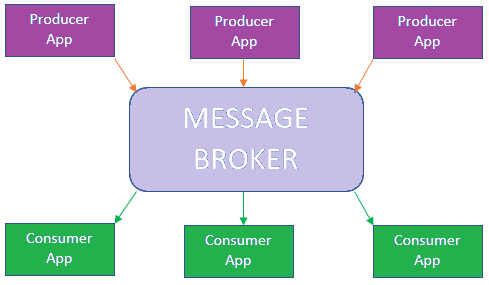How applications can communicate has become a deafening challenge.
But this is where the messaging middleware simplifies the challenge at hand – the internal communication among varying platforms.
Let’s answer the important question first; what is a Message Broker?
Message Broker
A message broker is software that facilitates common communication infrastructure – while scaling and growing to meet demanding conditions.
As far as communications are concerned, it can happen in many forms, and how the message broker facilitates communication is not so different but yet pioneering.
One way to facilitate communication used by message middleware is a server model that integrates and uses a message broker.
Using a message broker, the source application AKA the producer sends a message to the server process that provides data marshaling, message translation, routing, persistence, and delivery to all targeted destinations –also called the consumers.
The important characteristic of a message broker is its discrete service.
The producers and the consumers communicate with the broker using propriety and standard protocols. The message broker provides all state management and tracking of the clients, so the individual applications do not have to do it, and the complexity of the message delivery is built into the message brokers.
Types of Communication with Message Brokers
There come two basic types of communications via message broker, the first is publish and subscribe – topics, and the second is the point-to-point – queues.
Publish and Subscribe – Topics
When it comes to a publish and subscribe message system, the producers initiate a message on a relevant topic.
In this type, the producer is called a publisher, and the consumers are subscribers.
One or various publishers can publish on the same topic, and a message from one or many publishers can be received by numerous subscribers – that are subscribing to a particular topic. As subscribers subscribe to a topic, all messages published against a topic will be received by all subscribers.
This model facilitates a simple interest-driven delivery based on the topics that applications subscribe to.
Point-to-Point – Queues
In its simplest form, point-to-point communication has one producer and one consumer.
Such messaging type normally uses a queue for storing messages sent by the producer until they are delivered to the consumer.
The message producer begins the process by sending the message to the queue – then the message consumer re-claims messages from the queue and forwards an acknowledgment that the message is received.
Here, more than one producer can send a message to the same queue; similarly, more than one consumer can recover messages from the same queue. In case multiple consumers are being used, each will normally receive a portion of the message stream to facilitate the concurrent processing.
Server Message Brokers
Server-based message brokers offer many advantages – which include;
- Centralized Processing
- Centralized Message Distribution
- Centralized Data Persistence
Applications for this include many propriety message brokers, Java Message Service – JMS implementations, and open source products like Kafka, Pulsar, and Eclipse.
However, in the run of best message broker, Memphis{dev} takes the cake for its advanced structure, efficient working, and easy-to-use mechanism for developers.
What to consider while selecting a message broker?
Sustainable programming languages – Preferably, one should choose a message broker that supports multiple/different programming languages.
Supports messaging standards – ensure the message broker supports different standards such as AMQP, STOMP or if it is propriety.
Messaging Order — will the message broker keep the order of the incoming messages stored?
Delivery Guarantee – will the broker guarantee the delivery of messages without any data/information loss?
Tenacity — will the messages be saved to the disk, and by extension, can they survive a broker failure because of that?
Robustness — in a case when a consumer reconnects to the message broker, will they receive all of the messages that took place during their outage?
Scalability — check to see how scalable the message broker is.
Latency — what will be the end-to-end latency of the message broker?
Competing consumers — will the message broker sustain competing consumers?
Message Broker Trade-Offs
Every message broker will come with a different kind of trade-off.
Thus, low latency can be linked with out-or-order messages, storage only in RAM, and no delivery guarantees.
Persisting messages on the disk store them permanently but might offer higher latency.
Thus the selection of an appropriate message broker platform depends on your requirements.
Message Broker Use Cases
Message broker are used in software development when;
- Reliable multi services communication
- Guaranteed message delivery
- Asynchronous
-features are required.
The use case for message brokers vary, but below is our shot of pinpointing the popular ones;
Multi Destination Message Routing
With an efficient message broker, it gets easier and more manageable to publish messages to a single source from which multiple services can read.
Payment Processing
Payments should always be sent once and only once – handling this via message broker platforms ensures the payment information will not be lost or duplicated while additionally providing proof of receipt.
Read more:- Tranny Tube
Asynchronous Messages
With message brokers, it becomes possible to decouple heavyweight processing for live user requests – so the response is instant, and the user doesn’t get blocked.
For more information related to message brokers, visit Memphis{dev}.

